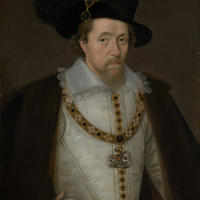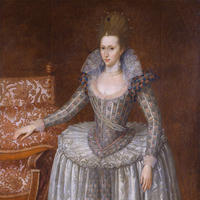More about John de Critz
Works by John de Critz

Contributor
John de Critz the Elder got his start through a connection to Francis Walsingham, the spymaster of Queen Elizabeth.
Among other things, Walsingham extracted, by ruthless means, information from Catholics about their activities in the British isles, keeping a grudge against them for various skirmishes between Catholics and Protestants. He also entrapped Mary, Queen of Scots, ensuring her execution. Walsingham took advantage of the fact that, as a child, de Critz and his family had arrived in England as refugees, fleeing the persecution of Protestants by the Catholic dons of the Spanish Netherlands. Wanting to do some Royal dirty deeds surreptitiously, Walsingham benefited from the fact people were less likely to suspect a young artist of espionage than, say, a mid-level bureaucrat with a shadowy past. Walsingham commissioned de Critz for paintings, but he also employed the painter as a messenger and mole in international operations. The professional adaptability of de Critz, while advantageous, has made many critics turn up their noses at him for failing to focus exclusively on fine art. Critics ash their cigars while they remark that de Critz, with his title of Royal "Serjeant Painter," is really "more of a painter than a picture-maker," as he also painted banners, buildings, and all kinds of royal paraphernalia.
The class connotations of shade-throwing comments like these refer to a hierarchy between "fine" or "high" art, like painting or sculpture, and "low art," which is everything else, including TV shows and billboards, and the other accessible things most people know about. In my day, it was the difference between Old Navy, the Gap, and Banana Republic, which are all owned by the same moguls, but cater to different classes of people. A rose by any other name, as Shakespeare wrote around the same time as de Critz hustled for the royal court, sells for a discount.
Some of the more blunt comments about de Critz's profession are from art historian William Gaunt, who characterizes the artist's realm of responsibility in the courts of James I and Charles I of England as "mainly that of a handyman." The labeling of de Critz as a handyman is controversial because, while true, it steamrolls the supposedly firm wall between everyday work, like maintenance, cleaning, repairs and other service jobs, and fine art.
There are as many correct ways to spell "de Critz" as there are ways to misspell Dostoevsky, or to mess up on a first date. In those days, spelling was not at all standardized, so people spelled "de Critz" according to the original Flemish pronunciation, the British pronunciation, their mood, the weather, and how much ink they had left.
When de Critz was almost forty, Walsingham died, and the painter had to find new work. This was especially important because he needed to support his family, which eventually counted sixteen(!) children, including a painter named John de Critz the Younger, and three wives. Thankfully, de Critz the Elder found work with James I of England, whose name adorns the sacred texts of Anglophone Christians, and Charles I, his successor. De Critz's sister Susanna married Marcus Gheerarts the Elder, De Critz's eldest sister, was also a Flemish Protestant refugee who painted in the English courts. Keeping it a family affair, de Critz sister Magdalena married Marcus Gheeraerts the Younger, the Elder's son. However, sister Susanna was Marcus the Elder's second wife and the Younger's stepmother, not his biological mother, so he wasn't Magdalena's nephew by blood. If this sounds confusing, think of the poor art historians who have to authenticate paintings from one or another of this intermarried tangle of court painters - it's a difficult task.
Sources
- Gaunt, William. Court Painting in England from Tudor to Victorian Times. London: Constable, 1980.
- Edmond, M. “Limners and Picture Makers.” Walpole Society 47 (1978–80).
- "The Serjeant-Painters." The Burlington Magazine 84, no. 493 (April 1944): 81.
- Tittler, Robert. "Three portraits by John de Critz for the Merchant Taylors' Company." The Burlington Magazine 147, no. 1228 (2005): 491-493.
- Town, Edward. "Whilst he had his perfect sight' - new information on John de Critz the Elder." Burlington Magazine 154, no. 1312 (2012): 482-486.
- Wagner, Kathrin, and Jessica David. Artists and Migration 1400-1850: Britain, Europe and beyond. Cambridge: Cambridge Scholars Publishing, 2017.
- Waterhouse, Ellis Kirkham. Painting in Britain, 1530 to 1790, Volume 1. New Haven: Yale University Press, 1994.
Featured Content
Here is what Wikipedia says about John de Critz

John de Critz or John Decritz (1551/2 – 14 March 1642 (buried)) was one of a number of painters of Flemish origin active at the English royal court during the reigns of James I of England and Charles I of England. He held the post of Serjeant Painter to the king from 1603, at first jointly with Leonard Fryer and from 1610 jointly with Robert Peake the Elder.
Check out the full Wikipedia article about John de Critz












